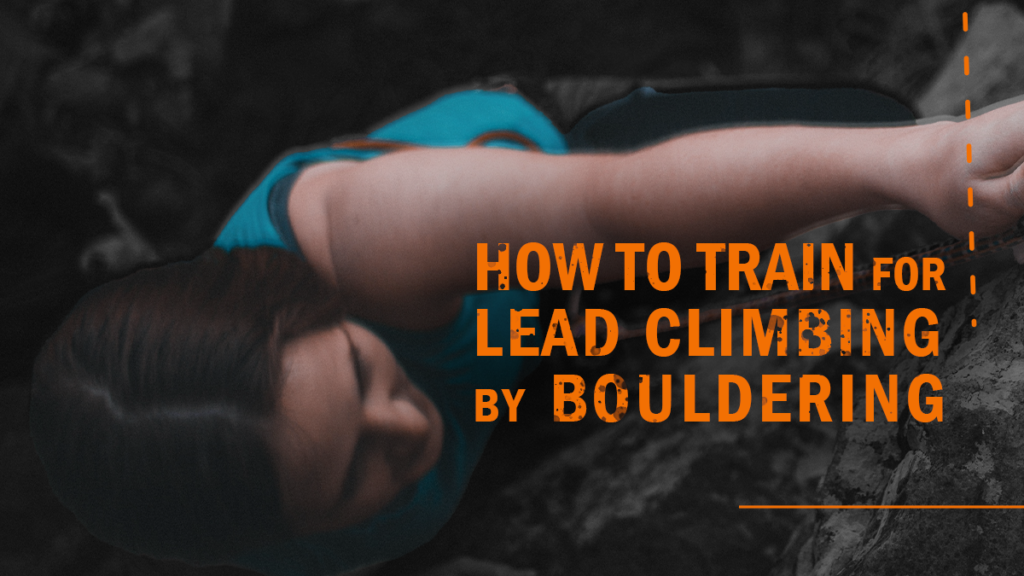For various reasons, you might find your nearest climbing gym outfit with only bouldering walls. If you’ve found a love for sport climbing, specifically lead climbing, this is less than ideal, as training for your outdoor projects may seem impossible with only bouldering at your fingertips.
Climbers may also face situations where they need more time to have a proper lead session. Or maybe you are in need of a lead partner because your friends have conflicting schedules, or worse, they are boulder loyalists. None of these situations support training for lead climbing by actually leading, so how can you accomplish lead training?
Training for lead climbing by bouldering can be highly efficient and effective. So, whether facility space, time, or lack of a belaytionship limits your workout, read on to learn how to start bouldering to improve your lead climbing.
How to Boulder for Lead Climbing Sends
First, think about what physical systems are critical to work on for preparing to lead. The obvious is endurance (some may call it fitness); the other, maybe less obvious, is power endurance. Power can be helpful when leading, but the route will likely have a few moderately hard moves in a row, followed by easier climbing or a solid rest, and then repeat that sequence to the top. Thus, you’ll need enough endurance to continually climb 40 to 100+ feet and power endurance to link the sections of hard moves between rests.
Luckily, power endurance is also important for bouldering, so there are plenty of exercises to dabble with. Endurance training will require patience and creativity, but it is 100% possible. We’ll start with power endurance workouts and then move into endurance-based bouldering sessions. If you are climbing four times per week, try to do two sessions for each area, alternating between the two each session. Also, pick one workout out of the suggested and do the other later in the week.
Power Endurance Training Regime
Unlike boulder power endurance, you’ll need to practice resting on the wall between hard move sequences versus resting on the pads. Try the following drills to target this area.
1. 4×4 – Up, Down, Up, Down Version
For a traditional 4×4, you climb moderate-hard problems, drop down to the mats, and repeat four times in four minutes.
For this version, you will pick a moderate-hard climb near an easy climb. Climb up the moderately hard climb, then down climb the easier climb. If needed, rest on the wall at the bottom before repeating the harder climb and down-climbing the easy problem again.
That completes one round, which should take 4 minutes or less. Rest off the wall for four minutes and complete three more rounds for a total of four rounds with four minutes rest between each.
If you thought a 4×4 was hard, this definitely ups the game. To make it easier, you can rainbow (use any holds) on the down-climb and rest on whatever hold feels best. Wear your smaller chalk bag while you complete these, as you ideally will not come up off the wall (so no rechalking from your chalk bucket).
2. # Moves
Think about your project on lead. Then, count up how many moves are on the climb. Then, add 15-30 to that number. Thus, if your project has 50 moves, you aim for 65-80 total moves completed during this workout. That’s all there is to the exercise: high-volume rounds of climbing on a system board, spray wall, or regular boulder wall without stopping. If you have to rest, do so on the wall. The moves should primarily combine easy and moderate moves, with a hard move or two thrown in every 5-7 moves.
Rest for 3-4 minutes to let your energy replenish.
Repeat 3-4 times.
Onto endurance training.
Endurance Training Regime
With endurance training, the goal is low-intensity volume climbing.
1. Repeaters
Basic, we know, but highly effective. Pick an easy boulder and repeat as many times as possible in 5 minutes, aiming for six plus ascents. Rest for 5 minutes. Do 5-6 rounds.
To increase the challenge, up the time or down climb. This workout will feel similar to a 4×4, but you want to choose climbs with better holds and lower effort required to achieve a higher volume session.
2. Color/Grade Circuit
Depending on how your gym distinguishes boulder problem difficulties, each climber’s workout will be slightly different. Either way, pick one identifier below your boulder onsight. Aim to complete the climbs of that difficulty within 30 minutes and with little to no rest between climbs.
Rest for 10-15 minutes.
Move up to the next difficulty, which should be at your onsight. Complete ten onsight climbs in 30 minutes.
If you start to fall during the ten boulders in 30 minutes, aim to put in high-quality effort and attempts, even if you don’t finish. Effort is more important than completion, as pushing through the fatigue will build your endurance capacity over time.
Bouldering for sport climbing is generally more translatable and beneficial than training on lead for bouldering. With bouldering, you can push the limits of your power, power endurance, and fitness, whereas lead climbing can make it harder to generate progress in your power endurance abilities. You can even recruit fellow boulderers to join in on your workouts and convert them to lead climbers once they see the payoffs!
Let us know in the comments below what you think of these workouts and if there are others you would recommend to fellow rock climbers!

